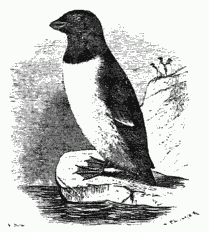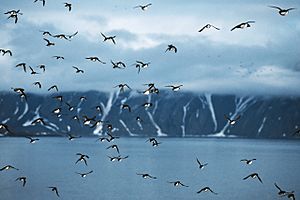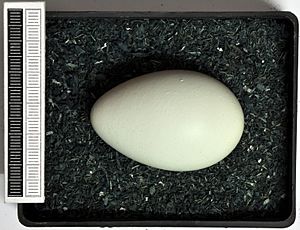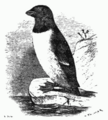Little Auk facts for kids
Quick facts for kids Little Auk |
|
|---|---|
 |
|
| Conservation status | |
| Scientific classification | |
| Kingdom: | |
| Phylum: | |
| Class: | |
| Order: | |
| Family: | |
| Genus: |
Alle
Link, 1806
|
| Species: |
A. alle
|
| Binomial name | |
| Alle alle (Linnaeus, 1758)
|
|
The little auk or dovekie (Alle alle) is a small auk. It's the only type of bird in its group, called Alle. The name Alle comes from the Sami language. It sounds like the call of a long-tailed duck. A long time ago, a scientist named Carl Linnaeus might have mixed up the little auk with the long-tailed duck because of how they looked in winter.
Little auks make their homes on islands in the far north, in the Arctic. There are two main kinds, or subspecies. One kind, A. a. alle, lives in places like Greenland, Iceland, Novaya Zemlya, and Svalbard. The other kind, A. a. polaris, lives on Franz Josef Land. A few also breed on Little Diomede Island in the Bering Strait. Some might also live on King Island, St. Lawrence Island, St. Matthew Island, and the Pribilof Islands.
Contents
What Little Auks Look Like and Do

The little auk is the only bird of its size in the Atlantic Ocean. It's about half the size of an Atlantic puffin. These birds are usually 19 to 21 centimeters (about 7 to 8 inches) long. Their wingspan is about 34 to 38 centimeters (about 13 to 15 inches).
Adult little auks have black feathers on their head, neck, back, and wings. Their bellies are white. They have a very short, thick beak and a small, round black tail. In winter, the lower part of their face and the front of their neck turn white.
Little auks fly straight and fast. Their short wings beat very quickly. Like other auks, they find food by swimming underwater. They mostly eat tiny sea creatures called crustaceans, especially copepods. They also eat other small invertebrates and small fish. Before they leave their nesting rocks to find food, they gather in huge groups. They do the same when they return.
When little auks are at their nesting places, they make many chirping and cackling sounds. But when they are out at sea, they are quiet.
Little Auk Life and Habitat
Little auks build their nests in huge groups on tall cliffs by the sea. They lay their eggs in cracks in the rocks or under large stones. Usually, they lay only one egg.
In winter, these birds move south to the northern parts of the North Atlantic Ocean. Sometimes, strong storms in late autumn can push them even further south than usual. They might even end up in the North Sea. You can also often find them in the Norwegian Sea.
The main animals that hunt little auks are the glaucous gull and the Arctic fox. Sometimes, even polar bears have been seen eating little auk eggs.
Protecting Little Auks
Even though the number of little auks seems to be going down, it's not happening fast enough to be a big worry right now. This is especially true because the total number of little auks around the world can change a lot. Scientists have found that little auks can handle changes in how much food is available. This is important because climate change can affect their food supply. They can change how they look for food, which makes it harder to know exactly how many there are.
Little Auks as Human Food
Kiviaq is a special dish made by the Inuit people in Greenland. To make it, they stuff a seal skin with 300 to 500 little auks. Once the skin is full and sealed tightly with seal fat, the little auks are left to ferment. This means they are left to change over time, usually for 3 to 18 months, under a pile of rocks. Little auks caught in the spring are an important food source for people in the winter.
Images for kids
See also
 In Spanish: Mérgulo atlántico para niños
In Spanish: Mérgulo atlántico para niños





